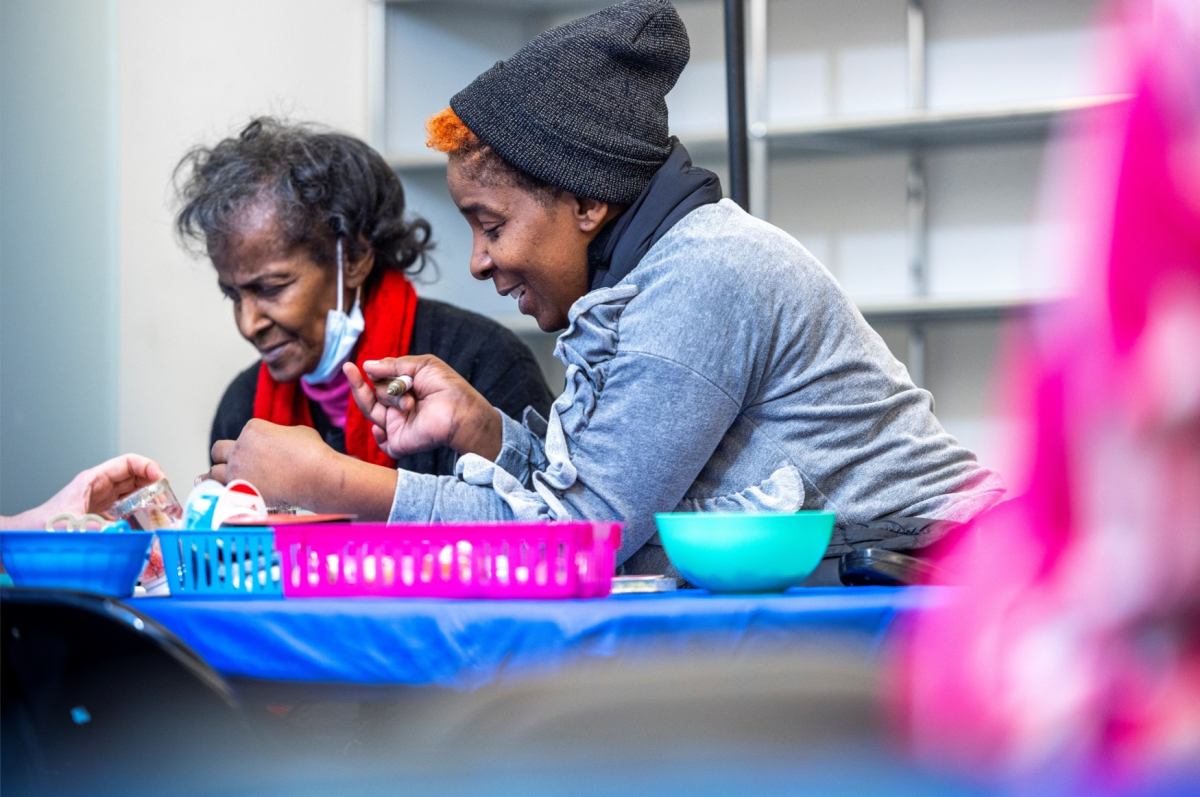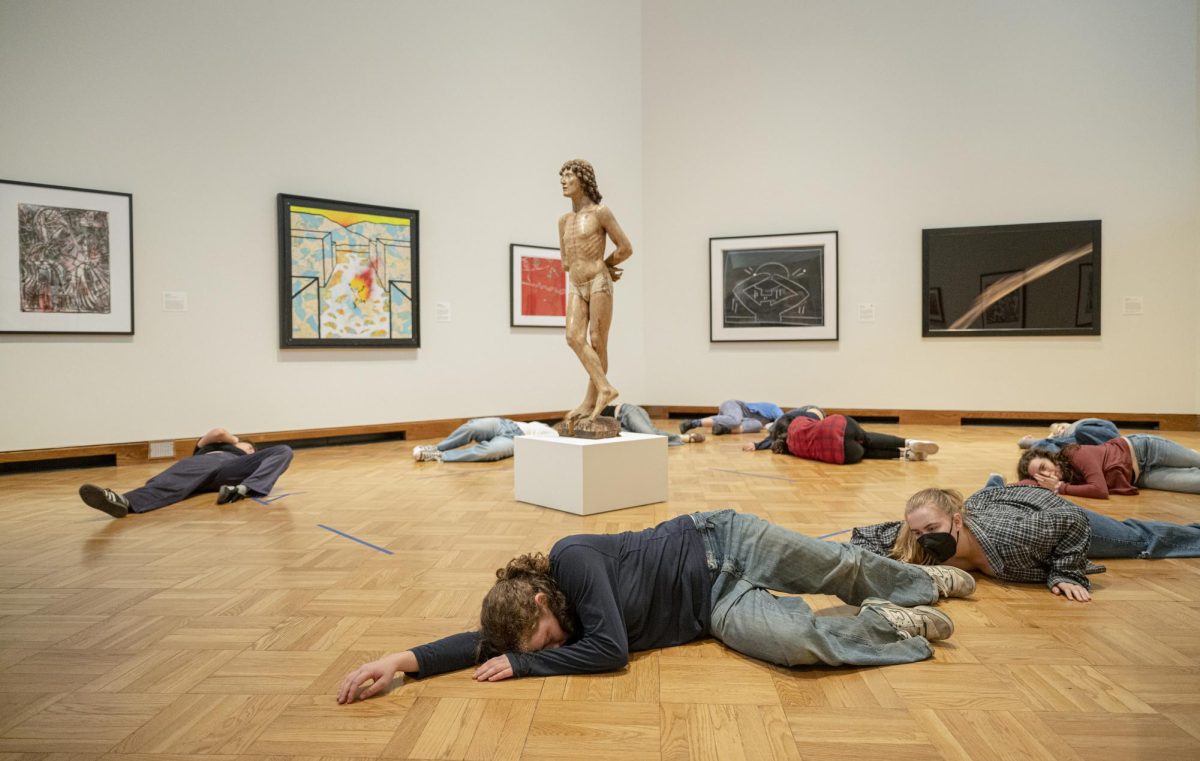To elevate the existing exhibit The Body, The Host: HIV/AIDS and Christianity in the Ellen Johnson Gallery at the Allen Memorial Art Museum, students from the Conservatory and the Theater department separately put on pieces that brought out its multi-faceted nature in “A Day of Connection: Art, Music, and HIV/AIDS” on April 13.
“The exhibition is a Venn diagram between works dealing with HIV/AIDS and Christianity,” Ellen Johnson ’33 Assistant Curator of Modern and Contemporary Art Sam Adams said. “Not all of [the pieces] are talking to each other, but they’re resonating with each other because of their shared themes.”
Beginning at 11 a.m., string quartets from the Conservatory, through a program developed by Associate Professor of Viola and Chamber Music Kirsten Docter and double-degree fourth-year Daniel Knapp, played a selection of music from 50 for the Future: The Kronos Learning Repertoire.
Aaron Wolff, OC ’17, performed selections by Arthur Russell, who died of AIDS-related illness in 1992. A gallery talk by exhibiting artist and activist Gil Kudrin, the director of development at Nightsweats & T-cells in Cleveland, followed these musical performances. Between the gallery talk by Kudrin and theater performances, visitors could find themselves in the East Gallery scanning archives and resources related to AIDS activism.
“We’re tapping into Oberlin College’s archives, representing activism on campus,” Coordinator of Student and Community Connection at AMAM Alyssa Traster said. “We’re tapping into the College library, artists’ books, the community LGBTQ Center [of] Lorain County, the campus’ Multicultural Resource [Commons], and the [Student] Health Center.”
In Ellen Johnson Gallery, theater performances under the umbrella of “The Body, The Host: A Collage Performance” ensued at 2 p.m. with an acapella song from double-degree first-year Calvin Ray Shawler’s original musical Wait for Me, Goodbye, Look Up, I Love You (2023).
“I think, as a gay man who has been raised in a Christian household, that sort of nuanced relationship between religion and sexuality is something that affects the way I am as a person naturally, and that in turn affects my work,” Shawler said. “So, I feel like it’s something I am naturally drawn towards writing about.”
Shawler wrote and composed this musical based on his hometown, which included many queer circles and many Christian circles. They note that, in creating this musical, they could talk to both circles and put them on the same side.
“A lot of the exhibit subverts religious ideals, which I think is often interpreted as disrespectful in a way that I don’t think is intended,” Shawler said. “I think there’s power in trying to find a way to allow the two to connect. It’s like the idea that we’re combining religious images with queer expression and we look at it as ‘this is being ruined by this, and this has been ruined by this’ as opposed to ‘these [two are] coming together [to] be appreciated as one higher form of art.’”
Movement by first-year Anna Steel accompanied Shawler’s acapella performance in addition to many other theater performances.
Steel’s movement, oftentimes undefined but in accordance with the tone of the actor—or singer, in Shawler’s case—provided an element of reinforcement of the ideas presented in the pieces performed and the artwork lining the walls behind.
“I really find it inspiring how different art forms, when you put them together, can elevate and pull out all of these surprising things you didn’t know existed,” Assistant Professor of Theater Anjanette Hall said. “It surprises me [that] we aren’t doing this more.”
Hall often brings her acting classes to AMAM to interact with the art and expressed excitement for the opportunity of her students to put on performances in this event.
“It’s a story that needs to be told,” Hall said. “[This event] is an incredible way to look at the [height of the HIV/AIDS epidemic] and think about the ways that [Christianity affected] the HIV/AIDS epidemic [and vice versa]. I hope people walk away thinking about the ways in which they affect each other.”
The common thread of these performances, scenes from Tony Kushner’s play Angels in America, illustrates the idea of looking at the HIV/AIDS epidemic in America through queer, non-queer, and Christian lenses and bringing them together.
“Faith, spirituality, fervor, religion, God, morality, AIDS, sex, desire, and queer love all come together in this amazing work of literature [Angels in America],” Adams said. “And the exhibition is laid out like that.”
Angels in America tells the story of the AIDS epidemic in New York City in the 1980s through the relationship between a closeted, married Mormon man and a gay man who’s contracted AIDS, as well as the people around them.
While much of the art in the exhibit and performances were created by HIV-positive and queer artists, some were not. An excerpt from Patti Smith’s Just Kids in which she talks about Robert Mappelthorpe, who died of AIDS-related illness and is exhibited, was included with accompanying movement by Steel.
By dedicating this exhibit to Bill Oleander, art curator and director at the AMAM from 1979–1984, Adams pays homage to the significant impact he had on the AMAM, including acquiring much of the HIV-positive artists’ works in the exhibit.
“It means a lot for me to share this with students today,” Adams said. “So much of what we do as an academic museum is intellectual, [but] this is different because it comes from the heart, and it’s very special to be able to do something like that. This is an intergenerational thing. We wanted to bring liveliness into the gallery to say ‘this is not dead, it’s not over.’ So we have students, young adults, bringing that element of liveliness into the gallery.”












